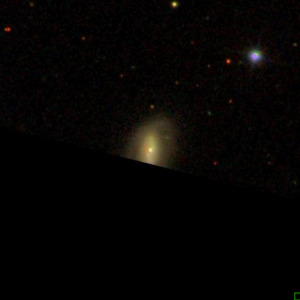NGC 1290
| Galaxy NGC 1290 |
|
|---|---|

|
|
| AladinLite | |
| Constellation | Eridanus |
|
Position equinox : J2000.0 , epoch : J2000.0 |
|
| Right ascension | 03 h 19 m 25.1 s |
| declination | -13 ° 59 ′ 23 ″ |
| Appearance | |
| Morphological type | E2? |
| Brightness (visual) | 14.8 mag |
| Brightness (B-band) | 15.8 mag |
| Angular expansion | 0.5 ′ × 0.4 ′ |
| Position angle | 85 ° |
| Surface brightness | 13.1 mag / arcmin² |
| Physical data | |
| Redshift | 0.008556 ± 0.000150 |
| Radial velocity | 2565 ± 45 km / s |
|
Stroke distance v rad / H 0 |
(112 ± 8) · 10 6 ly (34.4 ± 2.5) Mpc |
| history | |
| discovery | Ormond Stone |
| Discovery date | 1886 |
| Catalog names | |
| NGC 1290 • PGC 12395 • IRAS 03170-1410 • 2MASX J03192514-1359229 • GALEX ASC J031925.12-135922.8 | |
NGC 1290 is an elliptical dwarf galaxy from the Hubble type E in the constellation Eridanus at the southern sky . It is estimated to be 112 million light-years away from the Milky Way and has a diameter of about 15,000 light years
. a. the galaxies NGC 1295 , NGC 1296 , IC 318 .
The property was discovered by Ormond Stone in 1886 .
